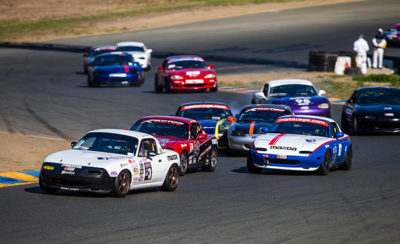After the field of shocks was narrowed to a few manufacturers, it was time to delve into details
Two days of testing that involved three drivers, four cars and seven damper manufacturers led to three setups that would go through the final phase of testing to determine the best choice for the new Spec Miata shock. Those three were shocks from current Spec Miata supplier Bilstein; AFCO, which built the shock used in the previous-generation MX-5 Cup car; and Penske, the eventual choice.
According to Joel Miller, one of the test drivers along with Randy Pobst and John Dean II, after the field was narrowed, each manufacturer was given the chance to make changes. After the first sessions, it became apparent to the drivers that the Bilstein and Penske had improved, while the AFCO had not. Cost to the customer was brought into the discussion at this point, and because the AFCO and Penske were priced similarly, the decision was made to further narrow the choice to Bilstein, the less expensive option, and the Penske, which the testers felt offered better performance than the similarly priced option.
At this point, weather played into the hands of the testers, presenting an opportunity for wet testing. The Toyo intermediates were fitted to two of the cars for a run in the rain.
“The result showed that the Bilstein ride quality was very rough although they had a good feel, but they required more pro-level driving knowledge to maximize the conditions due to the knife-edge nature of the chassis balance with that damper,” reports Miller. “The Penske was able to have very good compliance, producing a much friendlier car to drive in the rain because of a greater margin of error as well as the ability to slide the car with confidence.”
Once again, the manufacturers were allowed to adjust the valving for the fourth day of testing if they desired. Both the Hoosier SM8, a proposed tire for Spec Miata in SCCA, and the Toyo tire required by NASA were used. On the final day, each driver drove each car with both damper and tire combinations. Every run consisted of a 10-minute warm-up, a change to a second driver for a 30-minute race run, then a quick 10-minute evaluation for the third driver. The drivers maintained their roles throughout the day for consistency.
In the end, tire degradation over the course of a race run became a major consideration. It was one of many reasons that the Penske was the ultimate choice.
“The Penske damper had great compliance and was the benchmark from day one,” Miller said in his wrap-up report. “The ride quality was very good; the driver would not feel every bump in the road or seam in the track. The damper soaked up the exit curbing and did not skip the car when doing so. Tire life had a much more linear, yet subtler fall-off because of the good compliance. The tire also had a large window of operation and never gave a knife-edge feel at the end of the stint. This damper in the rain was very good as well, giving confidence in the brake zones plus mid-corner grip.”
Miller did note, however, that the shock they tested may limit ultimate lap times due to its compliance.
The first sets of the new Spec Miata shocks from Penske Racing Shocks will ship later this month, in plenty of time for racers to get them installed and tested prior to the first SCCA U.S. Majors Tour race of the season in January.
MazdaMotorsports.com will look at the final steps of the Spec Miata development process in an article in the near future.


 ACCESSIBILITY
ACCESSIBILITY